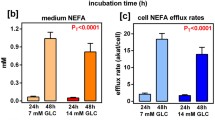Abstract
When fat cells are stimulated by a lipolytic agent such as ACTH, they are activated in such a way that a series of biochemical steps lead to activation of tissue lipase. The action of this enzyme on triglycerides causes the release of free fatty acids (FFA), among which is presumably arachidonic acid (AA). This is acted on by cyclo-oxygenase to produce endoperoxides, thromboxanes and prostaglandins (PGs). Prostaglandins, at least, have been shown to cause functional vasodilatation in vivo but perhaps some of the other products of the cyclo-oxygenase system also cause vasodilatation. In the experiments in which we examined subcutaneous adipose tissue in rabbits in vivo, FFA release was detected, the vasodilatation measured and the PG formation estimated in tissue extracts, obtained after activation of the adipose tissue by ACTH, and release of PGE2 into the venous blood measured by radioimmunoassay1,2. In addition investigations were carried out in chopped fat and isolated fat cells in vitro. FFA and glycerol levels and PG formation during activation of chopped fat and in isolated fat cells in vitro were also measured3.
Access this chapter
Tax calculation will be finalised at checkout
Purchases are for personal use only
Preview
Unable to display preview. Download preview PDF.
Similar content being viewed by others
References
Bowery, N. G., Lewis, G. P. and Matthews, J. (1970). The relationship between functional vasodilatation in adipose tissue and prostaglandin. Br. J. Pharmacol., 40, 437
Lewis, G. P. and Piper, P. J. (1975). Inhibition of release of prostaglandins as an explanation of some of the actions of anti-inflammatory corticosteroids. Nature (London), 254, 308
Chang, J., Lewis, G. P. and Piper, P. J. (1977). Inhibition by glucocorticoids of prostaglandin release from adipose tissue in vitro. Br. J. Pharmacol., 59 (In press)
Bowery, B. and Lewis, G. P. (1973). Inhibition of functional vasodilatation and prostaglandin formation in rabbit adipose tissue by indomethacin and aspirin. Br. J.Pharmacol., 47, 305
Vane, J. R. (1971). Inhibition of prostaglandin synthesis as a mechanism of action for aspirin-like drugs. Nature, New Biol., 231, 232
Lewis, G. P. and Piper, P. J. (1976). The action of corticosteroids on the prostaglandin system. In: The Role of Prostaglandins in Inflammation ( G. P. Lewis, ed.) pp. 148–160. ( Bern: Hans Huber Publisher )
Gryglewski, R. J., Panczenko, Bogumila, Korbut, R., Grodzinska, L. and Ocetkiewicz, A. (1975). Corticosteroids inhibit prostaglandin release from perfused mesenteric blood vessels of rabbit and from perfused lungs of sensitized guinea-pig. Prostaglandins, 10, 343
Kunze, H. and Vogt, W. (1971). Significance of phospholipase A for prostaglandin formation. Ann. N.Y. Acad. Sci., 180, 123
Blackwell, G. J., Flower, R. J., Nijkamp, F. P. and Vane, J. R. (1977). Phospholipase A2 activity of guinea-pig perfused lungs: stimulation and inhibition by anti-inflammatory steroids. Br. J. Pharmacol. 59 (In press)
Brain, S., Lewis, G. P. and Whittle, B. J. R. (1977). Actions of phospholipase on mast-cell histamine release and paw oedema in the rat. Br. J. Pharmacol., 59 (In press)
Weissman, G. (1973). Effect of corticosteroids on the stability and fusion of bio-membranes. ln: Asthma, Physiology, Immunopharmacology and Treatment (K. F. Austen and L. M. Lichtenstein, eds.) pp. 221–230. ( New York: Academic Press )
Tashjian, Jr., A. H., Voelkel, K. F., McDonough, J. and Levine, L. (1975). Hydrocortisone inhibits prostaglandin production by mouse fibrosarcoma cells. Nature (London), 258, 739
Gryglewski, R. J. (1976). Steroid hormones, anti-inflammatory steroids and prostaglandins Pharm. Res. Commun., 8, 337
Crutchley, D. J., Piper, P. J. and Seale, J. P. (1977). Relationship between prostaglandin inactivation and release in challenged guinea-pig lungs. J. Physiol. (London) (In press)
Author information
Authors and Affiliations
Editor information
Editors and Affiliations
Rights and permissions
Copyright information
© 1977 MTP Press Limited
About this chapter
Cite this chapter
Lewis, G.P., Piper, P.J. (1977). Two sites of action of steroids on the prostaglandin system. In: Willoughby, D.A., Giroud, J.P., Velo, G.P. (eds) Perspectives in Inflammation. Future Trends in Inflammation, vol 3. Springer, Dordrecht. https://doi.org/10.1007/978-94-011-7185-4_48
Download citation
DOI: https://doi.org/10.1007/978-94-011-7185-4_48
Publisher Name: Springer, Dordrecht
Print ISBN: 978-94-011-7187-8
Online ISBN: 978-94-011-7185-4
eBook Packages: Springer Book Archive




